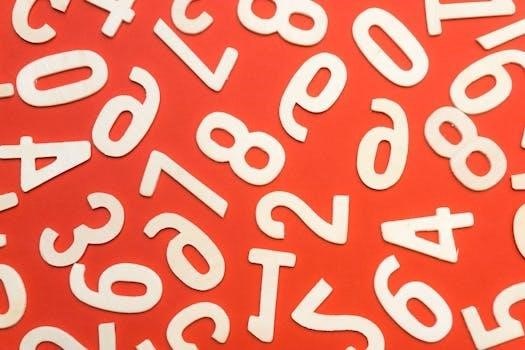In the realm of number theory, a perfect number is a positive integer that equals the sum of its proper divisors, excluding the number itself. These intriguing numbers have captivated mathematicians for centuries, revealing fascinating properties and connections within the world of numbers.
Definition of a Perfect Number
A perfect number is formally defined as a positive integer that is precisely equal to the sum of its positive proper divisors. Proper divisors are all the positive integers that divide the number evenly, excluding the number itself. For instance, if we consider the number 6, its proper divisors are 1, 2, and 3. Adding these divisors together (1 + 2 + 3), we obtain the sum 6, which is equal to the original number. Thus, 6 fulfills the condition of being a perfect number. This unique property distinguishes perfect numbers from other integers, setting them apart in the mathematical landscape. This definition highlights the specific relationship between a number and its factors, and has been studied in the field of number theory for a long time. The definition is quite specific and does not apply to many numbers.

Properties of Perfect Numbers
Perfect numbers possess unique characteristics, such as the relationship between the sum of their proper divisors and the number itself. These properties make them a special area of study in number theory.
Sum of Proper Divisors
The defining characteristic of a perfect number lies in the sum of its proper divisors. Proper divisors are all positive integers that divide a number evenly, excluding the number itself. For a number to be considered perfect, the sum of these proper divisors must equal the original number. For example, the number 6 has proper divisors 1, 2, and 3, and their sum (1 + 2 + 3) is equal to 6, making 6 a perfect number. This relationship between a number and the sum of its proper divisors is the core concept that defines perfect numbers. Understanding this property is crucial for identifying and exploring these special numbers. The specific calculation of proper divisors and their sum is fundamental to determining if a number is indeed perfect. This fundamental principle separates perfect numbers from other integers.
Even Perfect Numbers
All known perfect numbers are even, a fact that has intrigued mathematicians for ages. This observation has led to the development of a theorem that links even perfect numbers with Mersenne primes. This connection provides a way to generate even perfect numbers based on the existence of Mersenne primes. The relationship is that if 2p — 1 is a Mersenne prime, then 2p-1(2p — 1) is an even perfect number. Despite the extensive search for odd perfect numbers, none have been found, and whether they exist remains an open question. This enigma surrounding even and odd perfect numbers continues to drive research and exploration in number theory. The fact that all discovered perfect numbers are even highlights a particular property that is yet to be fully understood.

Examples of Perfect Numbers
Perfect numbers, while rare, do exist and are exemplified by numbers such as 6, 28, 496, and 8128. These numbers showcase the fascinating property of being equal to the sum of their proper divisors.
The Number 6 as a Perfect Number
The number 6 is the smallest and most well-known example of a perfect number. Its proper divisors, the numbers that divide it evenly excluding itself, are 1, 2, and 3. When these divisors are summed, 1 + 2 + 3, the result is 6, thereby fulfilling the definition of a perfect number. This makes 6 a foundational example in understanding the concept. The simplicity of 6 as a perfect number makes it an accessible starting point for exploring these unique integers. Its identification as a perfect number dates back to ancient times, where it held significance in various cultures. It is a simple yet powerful demonstration of this mathematical concept. The number’s status as the first perfect number makes it an ideal example for anyone first encountering the idea. This property makes it a perfect starting point when delving into the study of perfect numbers and their intriguing characteristics.
Other Perfect Numbers
Beyond the initial perfect number, 6, there exist other numbers that share this unique property of equaling the sum of their proper divisors. The next perfect number, following 6, is 28. Its divisors are 1, 2, 4, 7, and 14, and if you sum these, you will get 28. This further demonstrates the fascinating nature of these numbers. The next perfect number after 28 is 496, and after 496 the next one is 8128. These numbers, while less intuitive than 6, all follow the same principle of being equal to the sum of their proper divisors. Finding these perfect numbers becomes progressively challenging as they grow larger, requiring more sophisticated mathematical exploration. All discovered perfect numbers are even, and their discovery has always been an interesting challenge for mathematicians. The search for new perfect numbers continues to be an active area of mathematical research.

The Number 3 and Perfect Numbers
While the number 3 itself is not a perfect number, it plays an important role in number theory. It is also linked to the properties of perfect numbers, particularly in relation to Mersenne primes.
Is 3 a Perfect Number?
To determine if 3 is a perfect number, we must examine its divisors. The proper divisors of 3 are only 1, as 3 is a prime number. A perfect number is defined as a positive integer that is equal to the sum of its proper divisors. In the case of 3, the sum of its proper divisors is just 1. Since 1 is not equal to 3, we can conclude that the number 3 is not a perfect number. This is because it does not meet the fundamental criteria for perfection. Unlike 6, 28, and other perfect numbers, 3 fails to have a sum of divisors equal to itself, thus excluding it from the set of perfect numbers. The number 3 does however have a significant role in various mathematical concepts.
Relation to the Number 3
Although the number 3 is not a perfect number, it holds a significant place in mathematics and has connections to perfect numbers. While it doesn’t satisfy the specific criteria of a perfect number, its prime nature plays a role in the construction of perfect numbers. Specifically, the number 3 is a Mersenne prime, which are prime numbers that can be expressed in the form of 2p-1, where p is also a prime number. This link is crucial, as Mersenne primes are directly related to even perfect numbers. Every known even perfect number is generated from the formula involving a Mersenne prime. The number 3 itself appears within the perfect number of 6 (1+2+3=6), thus highlighting its role in the sum of divisors. Although 3 is not perfect, its role in forming perfect numbers is undeniable.

Mersenne Primes and Perfect Numbers
Mersenne primes, defined as primes in the form 2p-1, have a profound connection with perfect numbers. This relationship enables the discovery of even perfect numbers through a specific mathematical formula.
Link Between Mersenne Primes and Perfect Numbers
The connection between Mersenne primes and perfect numbers is a remarkable result in number theory. Specifically, every even perfect number can be generated using a Mersenne prime. If 2p ⏤ 1 is a Mersenne prime, then the number 2(p-1)(2p, 1) is a perfect number. This formula provides a direct link between these two types of numbers. For example, when p=2, 22-1=3, which is prime and 2(2-1)(22-1) = 2 * 3 = 6, a perfect number. The known even perfect numbers are all generated from this formula and each one corresponds to a known Mersenne prime. This significant relationship highlights the interconnectedness of mathematical concepts, and it is still an active area of research. The search for larger perfect numbers is directly linked to the search for larger Mersenne primes, with the discovery of each new Mersenne prime yielding a new even perfect number.



